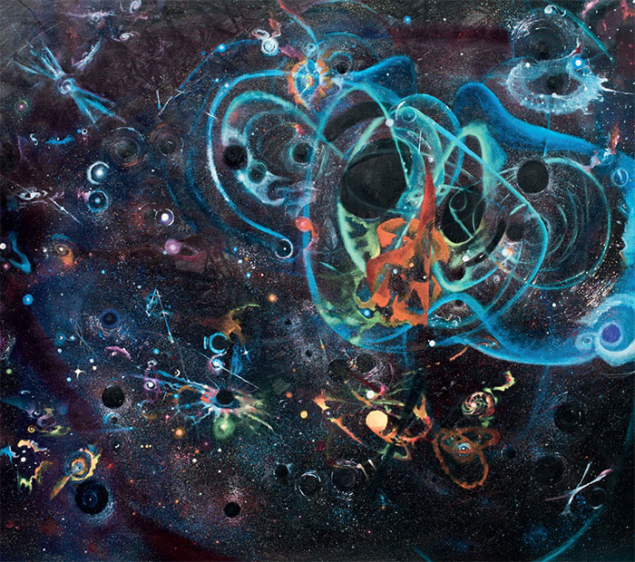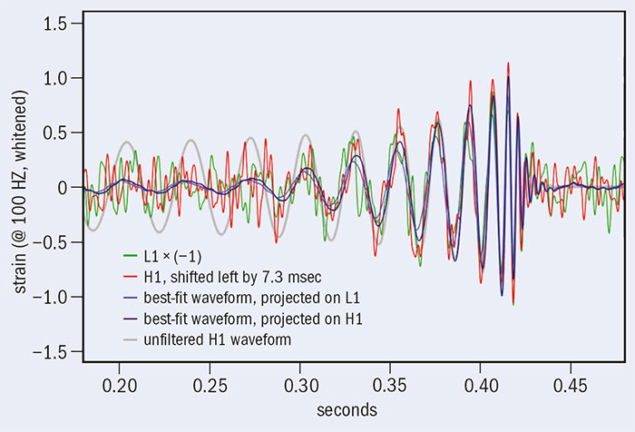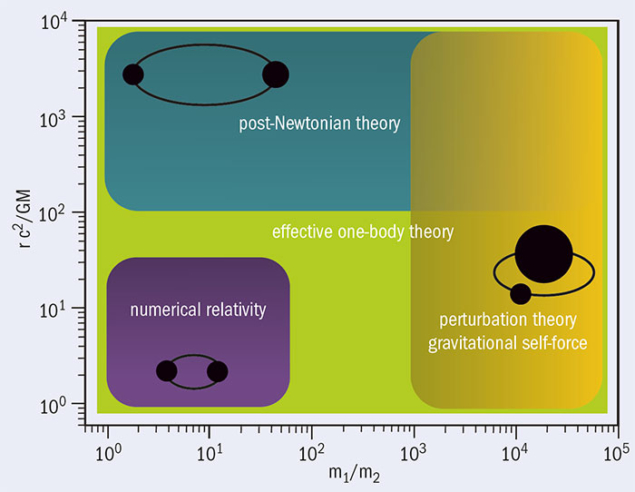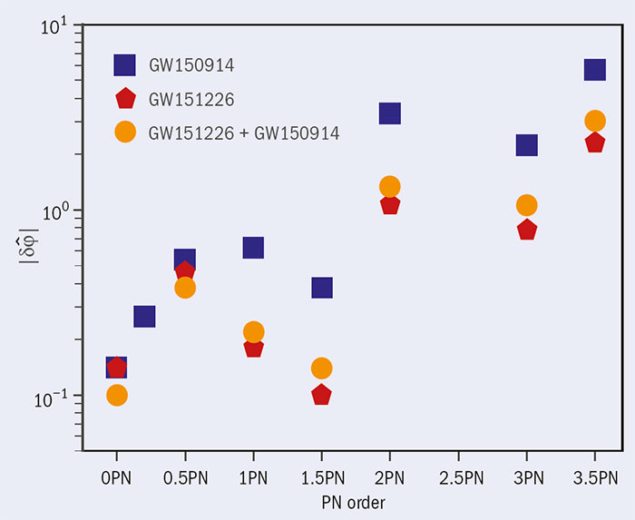Gravitational waves open a profound new vista on nature.

Image credit: Penelope Rose Cowley, www.peneloperosecowley.com.
One of the greatest scientific discoveries of the century took place on 14 September 2015. At 09.50 UTC on that day, a train of gravitational waves launched by two colliding black holes 1.4 billion light-years away passed by the Advanced Laser Interferometer Gravitational-wave Observatory (aLIGO) in Louisiana, US, causing a fractional variation in the distance between the mirrors of about one part in 1021. Just 7 ms later, the same event – dubbed GW150914 – was picked up by the twin aLIGO detector in Washington 3000 km away (figure 1). A second black-hole coalescence was observed on 26 December 2015 (GW151226) and a third candidate event was also recorded, although its statistical significance was not high enough to claim a detection. A search that had gone on for half a century had finally met with success, ushering in the new era of gravitational-wave astronomy.

Image credit: Phys. Rev. Lett. 116 061102.
Black holes are the simplest physical objects in the universe: they are made purely from warped space and time and are fully described by their mass and intrinsic rotation, or spin. The gravitational-wave train emitted by coalescing binary black holes comprises three main stages: a long “inspiral” phase, where gravitational waves slowly and steadily drain the energy and angular momentum from the orbiting black-hole pair; the “plunge and merger”, where black holes move at almost the speed of light and then coalesce into the newly formed black hole; and the “ringdown” stage during which the remnant black hole settles to a stationary configuration (figure 2). Each dynamical stage contains fingerprints of the astrophysical source, which can be identified by first tracking the phase and amplitude of the gravitational-wave train and then by comparing it with highly accurate predictions from general relativity.
aLIGO employs waveform models built by combining analytical and numerical relativity. The long, early inspiral phase, characterised by a weak gravitational field and low velocities, is well described by the post-Newtonian formalism (which expands the Einstein field equation and the gravitational radiation in powers of v/c, but loses accuracy as the two bodies come closer and closer). Numerical relativity provides the most accurate solution for the last stages of inspiral, plunge, merger and ringdown, but such models are time-consuming to produce – the state-of-the-art code of the Simulating eXtreme Spacetimes collaboration took three weeks and 20,000 CPU hours to compute the gravitational waveform for the event GW150914 and three months and 70,000 CPU hours for GW151226.
A few hundred thousand different waveforms were used as templates by aLIGO during the first observing run, covering compact binaries with total masses 2–100 times that of the Sun and mass ratios up to 1:99. Novel approaches to the two-body problem that extend post-Newtonian theory into the strong-field regime and combine it with numerical relativity had to be developed to provide aLIGO with accurate and efficient waveform models, which were based on several decades of steady work in general relativity (figure 3). Further theoretical work will be needed to deal with more sensitive searches in the future if we want to take full advantage of the discovery potential of gravitational-wave astronomy.
aLIGO’s first black holes
The two gravitational-wave signals observed by aLIGO have different morphologies that reveal quite distinct binary black-hole sources. GW150914 is thought to be composed of two stellar black holes with masses 36 MSun and 29 MSun, which formed a black hole of about 62 MSun rotating at almost 70% of its maximal rotation speed, while GW151226 had lower black-hole masses (of about 14 MSun and 8 MSun) and merged in a 21 MSun black-hole remnant. Although the binary’s individual masses for GW151226 have larger uncertainties compared with GW150914 (since the former happened at a higher frequency where aLIGO sensitivity degrades), the analysis ruled out the possibility that the lower-mass object in GW151226 was a neutron star. A follow-up analysis also revealed that the individual black holes had spins less than 70% of the maximal value, and that at least one of the black holes in GW151226 was rotating at 20% of its maximal value or faster. Finally, the aLIGO data show that the binaries that produced GW150914 and GW151226 were at comparable distances from the Earth and that the peak of the gravitational-wave luminosity was about 3 × 1056 erg/sec, making them by far the most luminous transient events in the universe.

Image credit: Max Planck Institute for Gravitational Physics/Simulating eXtreme Spacetimes project.
Owing to the signal’s length and the particular orientation of the binary plane with respect to the aLIGO detectors, no information about the spin precession of the system could be extracted. It has therefore not yet been possible to determine the precise astrophysical production route for these objects. Whereas the predictions for the rate of binary black-hole mergers from astrophysical-formation mechanisms traditionally vary by several orders of magnitude, the aLIGO detections so far have already established the rate to be somewhat on the high side of the range predicted by astrophysical models at 9–240 per Gpc3 per year. Larger black-hole masses and higher coalescence rates raise the interesting possibility that a stochastic background of gravitational waves composed of unresolved signals from binary black-hole mergers could be observed when aLIGO reaches its design sensitivity in 2019.
The sky localisation of GW150914 and GW151226, which is mainly determined by recording the time delays of the signals arriving at the interferometers, extended over several hundred square degrees. This can be compared with the 0.2 square degrees covered by the full Moon as seen from the Earth, and makes it very hard to search for an electromagnetic counterpart to black-hole mergers. Nevertheless, the aLIGO results kicked off the first campaign for possible electromagnetic counterparts of gravitational-wave signals, involving almost 20 astronomical facilities spanning the gamma-ray, X-ray, optical, infrared and radio regions of the spectrum. No convincing evidence of electromagnetic signals emitted by GW150914 and GW151226 was found, in line with expectations from standard astrophysical scenarios. Deviations from the standard scenario may arise if one considers dark electromagnetic sectors, spinning black holes with strong magnetic fields that need to be sustained until merger, and black holes surrounded by clouds of axions (see “Linking waves to particles”).
The new aLIGO observations have put the most stringent limits on higher post-Newtonian terms.
aLIGO’s observations allow us to test general relativity in the so-far-unexplored, highly dynamical and strong-field gravity regime. As the two black holes that emitted GW150914 and GW151226 started to merge, the binary’s orbital period varied considerably and the phase of the gravitational-wave signal changed accordingly. It is possible to obtain an analytical representation of the phase evolution in post-Newtonian theory, in which the coefficients describe a plethora of dynamical and radiative physical effects, and long-term timing observations of binary pulsars have placed precise bounds on the leading-order post-Newtonian coefficients. However, the new aLIGO observations have put the most stringent limits on higher post-Newtonian terms – setting upper bounds as low as 10% for some coefficients (figure 4). It was even possible to investigate potential deviations during the non-perturbative coalescence phase, and again general relativity passed this test without doubt.

Image credit: arXiv:1410.7832.
The first aLIGO observations could neither test the second law of black-hole mechanics, which states that the black-hole entropy cannot decrease, nor the “no-hair” theorem, which says that a black hole is only described by mass and spin, for which we require to extract the mass and spin of the final black hole from the data. But we expect that future, multiple gravitational-wave detections with higher signal-to-noise ratios will shed light on these important theoretical questions. Despite those limitations, aLIGO has provided the most convincing evidence to date that stellar-mass compact objects in our universe with masses larger than roughly five solar masses are described by black holes: that is, by the solutions to the Einstein field equations (see “General relativity at 100”).
From binaries to cosmology
During its first observation run, lasting from mid-September 2015 to mid-January 2016, aLIGO did not detect gravitational waves from binaries composed of either two neutron stars, or a black hole and a neutron star. Nevertheless, it set the most stringent upper limits on the rates of such processes: 12.6 × 103 and 3.6 × 103 per Gpc3 per year, respectively. The aLIGO rates imply that we expect to detect those binary systems a few years after aLIGO and the French–Italian experiment Virgo reach their design sensitivity. Observing gravitational waves from binaries made up of matter is exciting because it allows us to infer the neutron-star equation of state and also to unveil the possible origin of short-hard gamma-ray bursts (GRBs) – enormous bursts of electromagnetic radiation observed in distant galaxies.
Neutron stars are extremely dense objects that form when massive stars run out of nuclear fuel and collapse. The density in the core is expected to be more than 1014 times the density of the Sun, at which the standard structure of nuclear matter breaks down and new phases of matter such as superfluidity and superconductivity may appear. All mass and spin parameters being equal, the gravitational-wave train emitted by a binary containing a neutron star differs from the one emitted by two black holes only in the late inspiral phase, when the neutron star is tidally deformed or disrupted. By tracking the gravitational-wave phase it will be possible to measure the tidal deformability parameter, which contains information about the neutron-star interior, and ultimately to discriminate between some equations of state. The merger of double neutron stars and/or black-hole–neutron-star binaries is currently considered the most likely source of short-hard GRBs, and we expect a plethora of electromagnetic signals from the coalescence of such compact objects that will test the short-hard GRB/binary-merger paradigm.
Bursts of gravitational waves lasting for tenths of milliseconds are also produced during the catastrophic final moments of all stars, when the stellar core undergoes a sudden collapse (or supernova explosion) to a neutron star or a black hole. At design sensitivity, aLIGO and Virgo could detect bursts from the core’s “bounce”, provided that the supernova took place in the Milky Way or neighbouring galaxies, with more extreme emission scenarios observable to much further distances. Highly magnetised rotating neutron stars called pulsars are also promising astrophysical sources of gravitational waves. Mountains just a few centimetres in height on the crust of pulsars can cause the variation in time of the pulsar’s quadrupole moment, producing a continuous gravitational-wave train at twice the rotation frequency of the pulsar. The most recent LIGO all-sky searches and targeted observations of known pulsars have already started to invade the parameter space of astrophysical interest, setting new upper limits on the source’s ellipticity, which depends on the neutron-star’s equation of state.

Image credit: 2016 Phys. Rev. X 6 041015.
Lastly, several physical mechanisms in the early universe could have produced gravitational waves, such as cosmic inflation, first-order phase transitions and vibrations of fundamental and/or cosmic strings. Being that gravitational waves are almost unaffected by matter, they provide us with a pristine snapshot of the source at the time they were produced. Thus, gravitational waves may unveil a period in the history of the universe around its birth that we cannot otherwise access. The first observation run of aLIGO has set the most stringent constraints on the stochastic gravitational-wave background, which is generally expressed by the dimensionless energy density of gravitational waves, of < 1.7 × 10−7. Digging deeper, at design sensitivity aLIGO is expected to reach a value of 10−9, while next-generation detectors such as the Einstein Telescope and the Cosmic Explorer may achieve values as low as 10−13 – just two orders of magnitude above the background predicted by the standard “slow-roll” inflationary scenario.
Grand view
The sensitivity of existing interferometer experiments on Earth will be improved in the next 5–10 years by employing a quantum-optics phenomenon called squeezed light. This will reduce the sky-localisation errors of coalescing binaries, provide a better measurement of tidal effects and the neutron-star equation of state in binary mergers, and enhance our chances of observing gravitational waves from pulsars and supernovae. The ability to identify the source of gravitational waves will also improve over time, as upgraded and new gravitational-wave observatories come online.
Furthermore, pulsar signals offer an alternative Pulsar Timing Array (PTA) detection scheme that is currently operating. Gravitational waves passing through pulsars and the Earth would modify the time of arrival of the pulses, and searches for correlated signatures in the pulses’ times of arrival from the most stable known pulsars by PTA projects could detect the stochastic gravitational-wave background from unresolved supermassive binary black-hole inspirals in the 10−9–10−7 Hz frequency region. Results from the North-American NANOGrav, European EPTA and Australian PPTA collaborations have already set interesting upper limits on the astrophysical background, and could achieve a detection in the next five years.
The past year has been a milestone for gravitational-wave research in space, with the results of the LISA Pathfinder mission published in June 2016 exceeding all expectations and proving that LISA, planned for 2034, will work successfully (see “Catching a gravitational wave”). LISA would be sensitive to gravitational waves between 10−4–10−2 Hz, thus detecting sources different from the ones observed on the Earth such as supermassive binary black holes, extreme mass-ratio inspirals, and the astrophysical stochastic background from white-dwarf binaries in our galaxy. In the meantime, a new ground facility to be built in 10–15 years – such as the Einstein Telescope in Europe and the Cosmic Explorer in the US – will be required to maximise the scientific potential of gravitational-wave physics and astrophysics. These future detectors will allow such high sensitivity to binary coalescences that we can probe binary black holes in all our universe, enabling the most exquisite tests of general relativity in the highly dynamical, strong-field regime. That will challenge our current knowledge of gravity, fundamental and nuclear physics, unveiling the nature of the most extreme objects in our universe.







